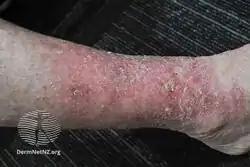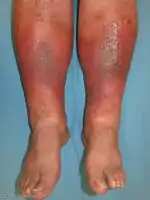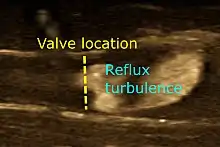Chronic venous insufficiency
| Chronic venous insufficiency | |
|---|---|
| Other names: Chronic venous disease, chronic peripheral venous insufficiency | |
 | |
| Chronic venous insufficiency | |
| Specialty | Vascular surgery |
| Symptoms | Lower leg swelling, skin changes, leg discomfort[1] |
| Complications | Venous ulcers, varicose veins, eczema, cellulitis[1] |
| Duration | Long term[1] |
| Types | Superficial, perforating, deep[2] |
| Risk factors | Genetics, high blood pressure, prolonged sitting, smoking, prior deep vein thrombosis, pregnancy, leg injury, prolonged standing[1][2] |
| Diagnostic method | Symptoms and examination[2] |
| Differential diagnosis | Heart failure, lymphedema, lipedema, dermatitis, cellulitis[1][2] |
| Treatment | Leg elevation, exercise, weight management, compression therapy, surgery[1] |
| Frequency | Common[2] |
Chronic venous insufficiency (CVI) is a condition in which blood pools in, rather than returns normally from the veins of the legs.[2] Symptoms may include lower leg swelling, skin changes, and leg discomfort.[1] Skin changes may include small visible blood vessels and skin discoloration.[2] Complications may include venous ulcers, varicose veins, eczema, and cellulitis.[1]
Risk factors include genetics, high blood pressure, prolonged sitting, smoking, prior deep vein thrombosis, pregnancy, leg injury, and prolonged standing.[1][2] The underlying mechanism involves high pressures, either due to backward flow or obstructed flow, within the veins.[1] Diagnosis is generally based on symptoms and examination, though may be supported by ultrasound.[2]
Initial treatment is generally with leg elevation, exercise, weight management, and compression therapy.[1] Some types can be improved with surgical therapies such as sclerotherapy or vein stripping.[1] Recurrence; however, is common after surgery.[1] The condition often gets worse with time.[1]
Chronic venous insufficiency is common.[2] In the United States about 6.5 million people are affected.[1] Older people are more commonly affected.[1] It appears to occur less commonly in non-Western countries.[1] Chronic venous insufficiency was described in Ancient India by Sushruta and later in Ancient Greece by Hippocrates.[3]
Signs and symptoms
Symptoms in the leg include the following:
- Varicose veins
- Itching (pruritus)
- Hyperpigmentation
- Phlebetic lymphedema[4]
- Chronic swelling of the legs and ankles
- Venous ulceration
Complications
CVI in the leg may cause the following:
- Venous stasis
- Ulcers.[5]
- Stasis dermatitis,[5] also known as varicose eczema
- Contact dermatitis,[5] a disrupted epidermal barrier due to venous insufficiency, making patients more susceptible than the general population to contact sensitization and subsequent dermatitis.
- Atrophie blanche,[5] an end point of a variety of conditions that appears as atrophic plaques of ivory white skin with telangiectasias. It represents late sequelae of lipodermatosclerosis where the skin has lost its nutrient blood flow.
- Lipodermatosclerosis, [5] an indurated plaque in the medial malleolus.
- Malignancy,[5] malignant degeneration being a rare but important complication of venous disease since tumors which develop in the setting of an ulcer tend to be more aggressive.
- Pain,[5] a feature of venous disease often overlooked and commonly undertreated.
- Anxiety[5]
- Depression[5]
- Inflammation
- Cellulitis
 Atrophie blanche
Atrophie blanche Venous eczema
Venous eczema Lipodermatosclerosis
Lipodermatosclerosis
Causes

The most common cause of chronic venous insufficiency is reflux of the venous valves of superficial veins. This may in turn be caused by several conditions:
- Deep vein thrombosis (DVT), that is, blood clots in the deep veins. Chronic venous insufficiency caused by DVT may be described as postthrombotic syndrome. DVT which triggers an inflammatory response subsequently injuring the vein wall.[6]
- Superficial vein thrombosis.
- Phlebitis
- May–Thurner syndrome. This is a rare condition in which blood clots occur in the iliofemoral vein due to compression of the blood vessels in the leg. The specific problem is compression of the left common iliac vein by the overlying right common iliac artery. Many May-Thurner compressions are overlooked when there is no blood clot. More and more of them get nowadays diagnosed and treated (by stenting) due to advanced imaging techniques.
Deep and superficial vein thrombosis may in turn be caused by thrombophilia, which is an increased propensity of forming blood clots.
Arteriovenous fistula (an abnormal connection or passageway between an artery and a vein) may cause chronic venous insufficiency even with working vein valves.
Diagnosis

History and examination by a clinician for characteristic signs and symptoms are sufficient in many cases in ruling out systemic causes of venous hypertension such as hypervolemia and heart failure.[7] A duplex ultrasound (doppler ultrasonography and b-mode) can detect venous obstruction or valvular incompetence as the cause, and is used for planning venous ablation procedures, but it is not necessary in suspected venous insufficiency where surgical intervention is not indicated.[7][6]
Insufficiency within a venous segment is defined as reflux of more than 0.5 seconds with distal compression. Invasive venography can be used in patients who may require surgery or have suspicion for venous stenosis. Other modalities that may be employed are: ankle-brachial index to exclude arterial pathology, air or photoplethysmography, intravascular ultrasound, and ambulatory venous pressures, which provides a global assessment of venous competence. Venous plethysmography can assess for reflux and muscle pump dysfunction but the test is laborious and rarely done.[6]
The venous filling time after the patient is asked to stand up from a seated position also is used to assess for CVI. Rapid filling of the legs less than 20 seconds is abnormal.[6]
Classification
CEAP classification is based on clinical, causal, anatomical, and pathophysiological factors.[8] According to Widmer classification diagnosis of chronic venous insufficiency is clearly differentiated from varicose veins.[9] It has been developed to guide decision-making in chronic venous insufficiency evaluation and treatment.[6]
The CEAP classification for CVI is as follows:
C0: no obvious feature of venous disease C1: the presence of reticular or spider veins C2: Obvious varicose veins C: Presence of edema but no skin changes C4: skin discoloration, pigmentation C5: Ulcer that has healed C6: Acute ulcer
Cause
Primary Secondary (trauma, birth control pill) Congenital (Klipper trenaunay) No cause is known
Anatomic
Superficial Deep Perforator No obvious anatomic location
Pathophysiology
Obstruction, thrombosis Reflux Obstruction and reflux No venous pathology
Management
Conservative
Conservative treatment of CVI in the leg involves symptomatic treatment and efforts to prevent the condition from getting worse instead of effecting a cure. This may include
- Manual compression lymphatic massage therapy
- Red vine leaf extract may have a therapeutic benefit.[10]
- Sequential compression pump
- Ankle pump
- Compression stockings
- Blood pressure medicine
- Hydroxyethylrutoside medication[11]
- Frequent periods of rest elevating the legs above the heart level
- Tilting the bed so that the feet are above the heart. This may be achieved by using a 20 cm (7-inch) bed wedge or sleeping in a 6 degree Trendelenburg position. Obese or pregnant people might be advised by their physicians to forgo the tilted bed.
Surgical
Surgical treatment of CVI attempts a cure by physically changing the veins with incompetent valves. Surgical treatments for CVI include the following:
- Linton procedures (i.e. subfascial ligation of perforating veins in the lower extremity, an older treatment)
- Ligation.[12] Tying off a vein to prevent blood flow
- Vein stripping.[12] Removal of the vein.
- Surgical repair.[12]
- Endovenous Laser Ablation
- Vein transplant.[12]
- Subfascial endoscopic perforator surgery.[12] Tying off the vein with an endoscope.
- Valve repair (experimental)
- Valve transposition (experimental)
- Hemodynamic surgeries.
Venous insufficiency conservative, hemodynamic and ambulatory treatment (CHIVA method) is an ultrasound guided, minimally invasive surgery strategic for the treatment of varicose veins, performed under local anaesthetic.[13]
Prognosis
CVI is not a benign disorder and with its progression lead to morbidity. Venous ulcers are common and very difficult to treat. Chronic venous ulcers are painful and debilitating. Even with treatment, recurrences are common if venous hypertension persists. Nearly 60% develop phlebitis which often progresses to deep vein thrombosis in more than 50% of patients. The venous insufficiency can also lead to severe hemorrhage. Surgery for CVI remains unsatisfactory despite the availability of numerous procedures.[6]
References
- 1 2 3 4 5 6 7 8 9 10 11 12 13 14 15 16 17 Patel, SK; Surowiec, SM (January 2020). "Venous Insufficiency". PMID 28613694.
{{cite journal}}: Cite journal requires|journal=(help) - 1 2 3 4 5 6 7 8 9 10 "Venous insufficiency". dermnetnz.org. DermNet NZ. Archived from the original on 5 January 2021. Retrieved 11 February 2021.
- ↑ Abela, George S. (2004). Peripheral Vascular Disease: Basic Diagnostic and Therapeutic Approaches. Lippincott Williams & Wilkins. p. 473. ISBN 978-0-7817-4383-9. Archived from the original on 2021-08-28. Retrieved 2021-02-11.
- ↑ Avril, Stéphane; Badel, Pierre; Dubuis, Laura; Rohan, Pierre-Yves; Debayle, Johan; Couzan, Serge; Pouget, Jean-Fraçois (January 25, 2012). Gefen, Amit (ed.). Patient-Specific Modeling in Tomorrow's Medicine. Springer. p. 220. ISBN 9783642246180. Archived from the original on August 15, 2019. Retrieved August 2015.
{{cite book}}: Check date values in:|accessdate=(help) - 1 2 3 4 5 6 7 8 9 Barron GS, Jacob SE, Kirsner RS (Sep 2007). "Dermatologic complications of chronic venous disease: medical management and beyond". Ann Vasc Surg. 21 (5): 652–62. doi:10.1016/j.avsg.2007.07.002. PMID 17823046.
- 1 2 3 4 5 6 Patel, Shivik K.; Surowiec, Scott M. (2020). "Venous Insufficiency". StatPearls. StatPearls Publishing. Archived from the original on 26 March 2021. Retrieved 9 July 2020.
 Text was copied from this source, which is available under a Creative Commons Attribution 4.0 International License Archived 2017-10-16 at the Wayback Machine.
Text was copied from this source, which is available under a Creative Commons Attribution 4.0 International License Archived 2017-10-16 at the Wayback Machine. - 1 2 Patrick C Alguire, Barbara M Mathes. "Diagnostic evaluation of lower extremity chronic venous insufficiency". Archived from the original on 2017-12-10. Retrieved 2017-09-12. Topic last updated: Dec 04, 2017.
- ↑ Antignani, P. L. (August 2001). "Classification of chronic venous insufficiency: a review". Angiology. 52 Suppl 1: S17–26. doi:10.1177/0003319701052001S03. ISSN 0003-3197. PMID 11510593.
- ↑ Hafner, Jürg (1999-01-01). Management of Leg Ulcers. Karger Medical and Scientific Publishers. p. 81. ISBN 9783805566544. Archived from the original on 2021-08-28. Retrieved 2019-08-16.
- ↑ Maryam Azhdari, Marzie Zilaee, Majid Karandish, Seyed Ahmad Hosseini, Anahita Mansoori, Mohadeseh Zendehdel, Sara Khodarahpour (2020). "Red Vine Leaf Extract (AS 195) Can Improve Some Signs and Symptoms of Chronic Venous Insufficiency, a Systematic Review". Phytotherapy Research. PMID 32314844.
{{cite journal}}: CS1 maint: uses authors parameter (link) - ↑ Frick, RW (March 2000). "Three treatments for chronic venous insufficiency: escin, hydroxyethylrutoside, and Daflon". Angiology. 51 (3): 197–205. doi:10.1177/000331970005100303. PMID 10744007.
- 1 2 3 4 5 "Chronic Venous Insufficiency". hopkinsmedicine.org. Archived from the original on 2014-05-22. Retrieved 2014-05-22.
- ↑ Mowatt-Larssen, Eric; Shortell, Cynthia (2010). "CHIVA". Seminars in Vascular Surgery. 23 (2): 118–22. doi:10.1053/j.semvascsurg.2010.01.008. PMID 20685567.
External links
| Classification | |
|---|---|
| External resources |